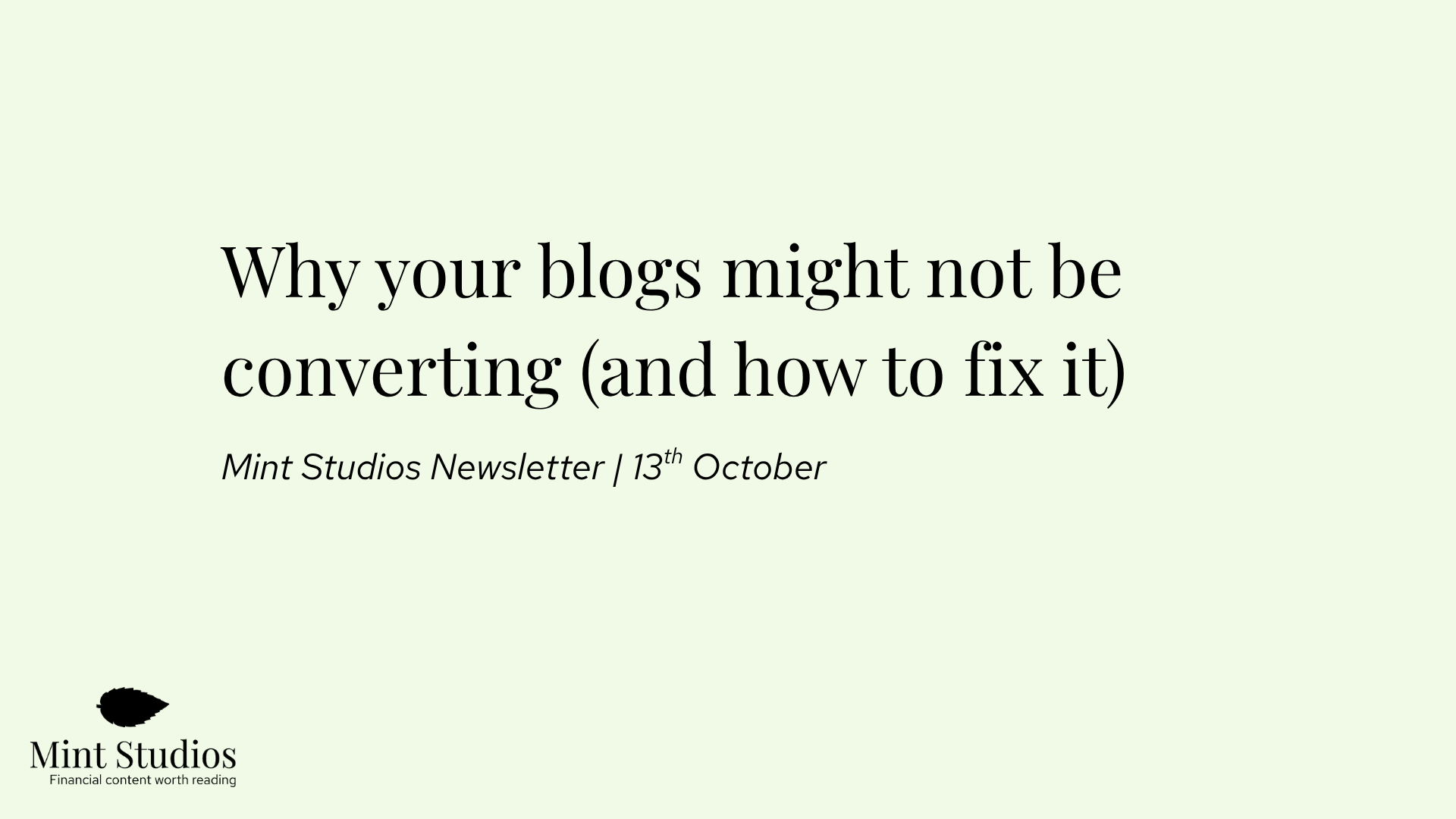Over the years, the definition of content and SEO has changed. The way that companies, agencies and freelancers do content has also changed.
We’ve reached a point where content is seen as a commodity, as a standard part of the marketing mix. Written content isn’t given much thought; articles are put on the blog, a few stock images are slapped on and boom: we’re doing content marketing.
Written content is now seen as a marketing activity that is designed to make the company look good. People only do content marketing because everyone else is doing it; that’s why there is so much noise. Marketers and writers are writing content for the sake of it, or because they’re being paid to do it, fully knowing the only person who will read this is the editor.
We’ve reached a point where content is produced by content mills, trying to reach a target number of words and X amount of “blog posts” per month. Instead of using content as a tool or enabler for growth, it’s an expense, a nice to have.
And if you read the articles themselves, you can see it in the writing. There is no real thought or effort put into these articles – they’ve been outsourced to an underpaid writer who wasn’t given much context and no training on the product or market.
This is how you end up with articles that focus on writing definitions, recycling white papers and using the same cliches as everyone else. There is no genuinely actionable or useful content. Instead of writing for their target market, one year old companies are prioritising “thought leadership” rather than publishing content that can help with customer acquisition.
And it’s not even good thought leadership. It’s recycled content from three different white papers. There’s no real different perspective, no real “thought” that goes into these articles. “How to build a digital bank” and then citing the same steps as every other white paper and report is not thought leadership.
But it’s also no surprise. Content is often outsourced to the wrong people. It’s outsourced to agencies that compete based on the number of blog posts per month they can deliver, rather than creating seriously engaging, useful content that can help the company grow. They’re accountable for the wrong metrics, which results in content that no one wants to read.
And with ChatGPT and content AI tools, the quality of content is reaching new lows.
However, there is a revolution happening.
A handful of content agencies, freelancers and in-house marketers are choosing to do content differently. Content that is designed to help the company grow, or that genuinely expresses a different point of view. Content that is based on interviews with experts, that has been carefully crafted to be useful and engaging for the reader.
These are people who understand the extraordinary power of content: to attract customers by educating them. They understand that content is not just a tactic, it’s a company mindset. One where people prioritise giving the customer or prospect the right information, rather than straight selling the product.
We’ve put together 10 proclamations that we believe describe the new way to write and create written content for the website. A way that empowers companies as well as customers simultaneously: one by positioning themselves as an expert, and the other with knowledge.
These are the proclamations we follow at Mint Studios and the ones we enable with our clients.
First proclamation: We will write for our audience
Gone are the days of writing content that is designed solely to rank on Google, and not to educate a prospect. Gone are the days of writing about “top Chirstmas X ideas” and “X payment trends” rather than writing real, educational and useful content.
Before writing an article, we’ll take the time to understand what our target reader’s pain points and challenges are. And no, that doesn’t mean adding a couple of sentences in a content brief and hoping the writer understands.
Instead, we will encourage the writer to put themselves in the position of their target audience. Before writing an article, they should be able to answer questions like: what is the main challenge that someone looking this up will be facing? What are their pain points? How does our product solve those problems?
We won’t write content for the sake of it. Each piece of content will have a purpose which is closely linked to the company proposition.
95% of the time, the content we write will target our audience, our target market. Whether that’s buyers, or people who are part of the decision making team. The rest of that 5% is content designed to help with backlinks, or PR.
Second proclamation: Our content will be based on expertise
If one of our company’s values is financial education and we care about educating our audience, then our content should come from a place of expertise.
We don’t need another article on “types of payment methods” that lists out the same payment methods that everyone else does.
Instead, our articles will be based on expertise. That could be by doing an interview with an expert on our team, internal or external.
We will no longer ask writers to write an expert-based article without the help of an expert (unless the writer is an expert themselves). We won’t burden them with the requirement to read five white papers and summarise what they found. Instead, we will set them up with an interview with an expert, or allow them to conduct the interview.
Our readers don’t need to read another article that is rewritten from another article or white paper. They need to read something new. We won’t write an article unless we can add something to the conversation.
Third proclamation: Our content strategy will be based on customer research, not competitors’ rankings
The world doesn’t need another keyword spreadsheet that is an exported CSV file of all the keywords that our competitors are ranking for.
When it comes to creating a strategy and coming up with content ideas, we’ll do this based on research of our customers.
If we can’t sit down with our customers and interview them, we’ll sit down with our sales team and the most customer-facing people on our team and ask them questions about our customers.
We’ll take the time to understand their pain points, challenges and questions, and understand who they are comparing us to.
We’ll create a content strategy and calendar that focuses on answering customers’ questions, that builds on our strengths and takes advantage of opportunities in the market. We won’t rely on Ahrefs or SEMRush to tell us what to write about.
Fourth proclamation: We won’t do Top of the Funnel content until we’ve done all the Bottom of the Funnel content
Unless we have a huge marketing budget and can target the entire funnel at the same time, we’ll start by creating content that focuses on Bottom of the Funnel content. This will help us get customers and leads in the door, and will help us reach any immediate revenue goals.
The prospects at BOFU are people who know what their problem is, what the solution is and are actively looking for a solution. Not targeting these people means leaving customers and therefore revenue on the table. It doesn’t make sense to not target these people first.
This way, we’ll get results more earlier on, keeping the leadership team and board happy. Once we feel comfortable with our efforts at the BOFU, then we’ll work our way up and target a larger audience.
Fifth proclamation: We won’t shy away from talking about our product (in an ethical way)
Content is an opportunity to turn readers into customers. Even content for brand awareness and thought leadership has the same ultimate goal: customer acquisition.
If we don’t feel comfortable talking about our product, then there might be another issue at play: we don’t feel our product is helpful enough or we might be targeting the wrong market. It might be time to go back to the drawing board on product strategy.
If we sincerely believe that our product helps others, then we’ll mention our features and company wherever necessary. We’ll aim to be transparent with the reader, admitting that our product isn’t a good fit for everyone. We’ll even go so far as to admit that in some cases, our competitors are a better fit.
When talking about our product, we’ll make sure to use examples to showcase how it works. We’ll add screenshots, and explain the product in detail. We won’t shy away from talking about pricing.
Sixth proclamation: We’ll involve product and compliance in our discussions
To avoid many back and forths, wasted energy and issues with the regulator, we’ll make sure product and compliance are part of discussions early on. We’ll check the topics with them to make sure they’re happy with the content strategy and calendar.
Finally, we’ll make sure the team understands why we’re creating content. Ultimately, content will reduce the need for outbound lead generation, and will help grow the company. Content helps everyone, so it’s important that this is clear from the beginning.
Seventh proclamation: We won’t shy away from talking about competitors (when compliance allows)
True content marketing is customer-centric: focused on educating the reader and giving them the information they need to then make their own decision — rather than only talking about our product.
Customers are not stupid. If they don’t know about our competitors, they will find out in two seconds. So why not own the narrative and be upfront about the differences?
If we want to be trusted by the reader, we need to be comfortable talking about competitors. We need the leadership team and board to understand that if someone does read our article and does pick our competitor, they weren’t a good fit in the first place.
Eighth proclamation: We will adopt a content philosophy where we choose to be a teacher
Content marketing is about attracting customers by educating them.
In order for this to work, we need to adopt the content philosophy of choosing to educate and give information, rather than hard sell. We choose to be a teacher, rather than a pushy salesperson. There are ways to “sell” and talk about our product in a way that is educational and empowers the customer. That’s what we want to aim for.
We choose to be transparent about our pricing and products on our website. We’ll try to answer all our customers’ questions, no matter how hard they are.
Ninth proclamation: We will put in the effort to track the results of our content
Many people argue you cannot track the ROI of content.
And they’re right.
However, anyone who works in the real world – especially in companies that aren’t run by marketers – knows that the leadership team will want to see numbers. They want to be able to calculate the return on their content investment.
The return on investment could take years – we’re not saying it will be immediate. The point is that we want to make sure we’ve got the tracking in place. We’ve been given a gift in the digital marketing world: we can actually track how people interact with our content. Let’s use that gift, and use it to empower us and get us a seat at the leadership table.
By tracking the results of our content, we can prove its value. This will allow us to get a bigger budget, or more flexibility.
We’ll aim to work with our higher ups, not against them. And the best way to do this is to track and report the results of our efforts.
We’ll also try to make the tracking as accurate as possible. If possible, we’ll use Hubspot and link it to our CMS so we can see who reads our content and the quality of the prospects that come in. If that’s not possible, we’ll learn how to use Google Tag Manager so we can attribute leads to specific pieces of content.
We’ll use these numbers to empower our content work, and to further embrace the power of content.
Tenth proclamation: If we work with an external content partner (agency/freelancer), we’ll ensure they are helping with growth and not just meeting an arbitrary goal
Instead of working with an agency whose success metrics is 5 blog posts per month, we’ll keep them accountable for the results. We’ll work with an agency that understands that content is a tool to enable growth and customer acquisition, not just to look pretty on a website.
When an agency is aligned on outcomes rather than outputs, the quality of content drastically increases. That’s because the content partner understands they need to do the best possible content in order to help the company reach their customer acquisition goals.
And no, we’re not just talking about traffic. Anyone can help increase traffic to a website – and an increase in traffic does not equal an increase in leads or customers. That’s why content partners need to be held accountable for the metric that matters: revenue.
Ultimately, if we want the best possible quality and the best possible results, we need to work with someone who is accountable for performance. If we don’t, we will forever complain about the quality of content.
If we wish to truly embrace the content mindset in a way that helps us grow, then we need to work with someone who shares this approach. It’s not worth working with someone who doesn’t.
These ten proclamations clearly state the new way to do content, one which leaves content mills, arbitrary goals and a lot of wasted money behind. One where content is embraced as a way to grow a company.
The more we engage in these proclamations, the more we see the power of content and the opportunity.
The cause of the content revolution is not to stop everyone from publishing content; it is to make sure to only engage in content for the right reasons, with the right mindset and the right partners. As companies, we want to use content to help make an impact on the world.
We will master the ten proclamations so that we can make the most of content and use it in the best way possible. We will create great content that helps grow the company, that educates the customer and that helps establish us as experts. Honesty, transparency, alignment and focus — these are the steps to creating content that serves us.











